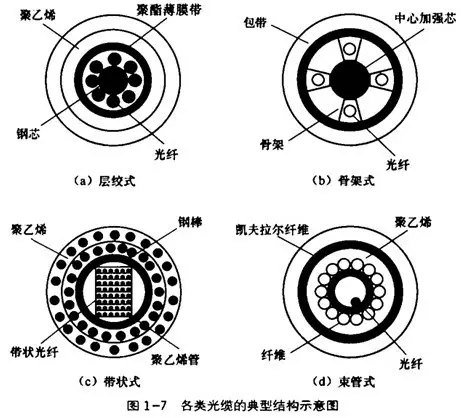
Blog
blog Location: Home > Blog > Technical Article
Location: Home > Blog > Technical Article
 Update Time:2025-08-14
Update Time:2025-08-14 Traffic:
Traffic: 16. In current commercial optical fibers, which wavelength of light has the smallest dispersion? Which wavelength of light has the smallest loss?
Answer: Light with a wavelength of 1310nm has the smallest dispersion, and light with a wavelength of 1550nm has the smallest loss.
17.How are optical fibers classified based on changes in the refractive index of the optical fiber core?
A: It can be divided into step-index fiber and gradient-index fiber. Step-index fiber has a narrower bandwidth and is suitable for small-capacity short-distance communications; gradient-index fiber has a wider bandwidth and is suitable for medium- and large-capacity communications.
18.How are optical fibers classified according to the different light wave modes transmitted in them?
A: It can be divided into single-mode fiber and multi-mode fiber. The core diameter of single-mode fiber is about 1 to 10 μm. At a given working wavelength, it only transmits a single fundamental mode, which is suitable for large-capacity and long-distance communication systems. Multi-mode fiber can transmit multiple modes of light waves, with a core diameter of about 50 to 60 μm, and its transmission performance is worse than that of single-mode fiber.
When transmitting the current differential protection of multiplexed protection, multimode optical fiber is often used between the optoelectronic conversion device installed in the communication room of the substation and the protection device installed in the main control room.
19.What is the significance of the numerical aperture (NA) of step-index optical fiber?
Answer: Numerical aperture (NA) indicates the light-collecting ability of optical fiber. The larger the NA, the stronger the light-collecting ability of optical fiber.
20.What is birefringence of single-mode optical fiber?
Answer: There are two orthogonal polarization modes in single-mode optical fiber. When the optical fiber is not completely cylindrically symmetrical, the two orthogonal polarization modes are not degenerate. The absolute value of the difference between the refractive indices of the two orthogonal polarization modes is birefringence.
21.What are the most common optical cable structures?
Answer: There are two types: layer twisted type and skeleton type.

22.What are the main components of optical cable?
Answer: It is mainly composed of: fiber core, optical fiber grease, sheath material, PBT (polybutylene terephthalate) and other materials.
23.What does the armor of optical cable mean?
A: It refers to the protective element (usually steel wire or steel belt) used in optical cables for special purposes (such as submarine optical cables, etc.). The armor is attached to the inner sheath of the optical cable.
24.What materials are used for optical cable sheaths?
Answer: The optical cable sheath or protective layer is usually made of polyethylene (PE) and polyvinyl chloride (PVC) materials. Its function is to protect the cable core from external influences.
